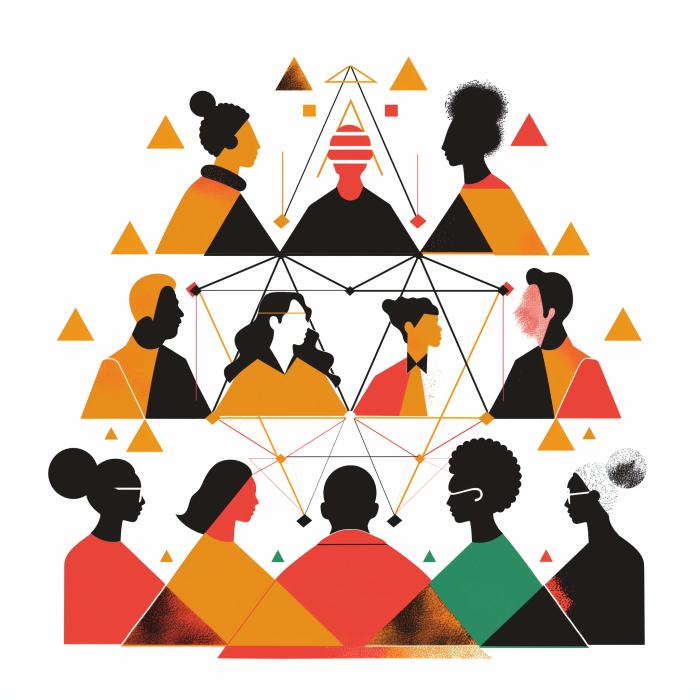BEYOND LABELs
INCLUSIVE DESIGN IN DIGITAL METADATA

後設資料包容性設計手冊
一本關於數位典藏後設資料的文化平權策略指南
1.2
1.3 後設資料包容性的設計原則 12 A Better Way
2.1 後設資料包容性設計行動目標 20 Goals for Inclusive Action
2.2 組織領導者的行動任務 22 The Role of the Organizational Leader
2.3 後設資料包容性設計行動計畫 24 Inclusive Design Action Plan 3.1
CONTENTS 參考文獻 52 References 前言 4 Idea in Brief
大思考:回顧典藏數位化
1.1
8 The Big Idea: Rethinking the Digital Archive
後設資料建構 10 Traditional Approaches
後設資料包容性設計的五大問題
3.2
34 Five Questions About Inclusive Metadata
實踐後設資料包容性的五步驟 44 Five Steps to Inclusive Metadata
3.3 包容性設計的下一步 50 Navigating the Future Landscape 1 2 3 4
前言 Idea in Brief
《後設資料包容性設計手冊》中,概述後設資料作為全世 界通用的開放資源,需要關注的包容性議題,並提供各類 機構在制定組織的後設資料包容設計方案、策略和政策時, 可供參酌的原則。
近年來,因應資訊發展和數位化普及,國際網際網路上的 資訊往來廣泛且密切,文化脈絡與觀點各自交匯,各類數 位資源開放給本地和跨國的民眾使用已成常態。
This Handbook on the Inclusivity of Metadata provides an overview of the inclusivity issues that require attention when metadata serves as a universally accessible open resource worldwide. It offers principles for various institutions to consider when developing inclusive design schemes, strategies and policies for organizing metadata.
In recent years, with the advancement of information technology and digitalization, the exchange of information on the internet has become widespread and interconnected, with cultural contexts and perspectives intersecting. Various electronic resources are routinely made accessible to local and transnational audiences.
其中世界各國GLAM(美術館 Gallery、圖書館 Library、 檔案館 Archive、博物館 Museum)的典藏單位,應用快速 發展的數位技術保存文化和歷史資源,並開放分享數位化 的物件和檔案,擴大知識交流與創新,豐富公眾的知識建 構和文化體驗。
Among these are the collections of GLAM institutions (Galleries, Libraries, Archives, and Museums) worldwide, which utilize rapidly evolving digital technologies to preserve cultural and historical resources and share digitized objects and archives openly, thereby enhancing knowledge exchange, innovation, and enriching the public's knowledge construction and cultural experiences.
當國家收藏的開放資源在全球化世界通用,將會需要有更 多元觀點和精確的轉譯體現,像是關注文化敏感度和去殖 民化等議題,才能避免呈現內容使公眾價值產生或加劇偏 見。
參考本手冊內容可協助機構制定能針對所有員工適用的全 面性策略;提供清晰的策略結構,協助組織推動後設資料 包容性設計時,系統性建立行動方針的優先順序。賦能負 責此業務的員工,創建具體可行的行動,消除執行後設資 料包容性設計的不利因素。
As open resources, collected by nations and communities, become universally accessible in a globalized world, there is a need for a more diverse range of perspectives and accurate translations to address issues such as cultural sensitivity and decolonization. This is crucial to prevent the presentation of content from generating or exacerbating biases among the public.
Referencing the content of this handbook can assist institutions in formulating comprehensive strategies applicable to all employees. It provides a clear strategic framework to assist organizations in promoting the inclusive design of metadata, and thus systematically establishing action plans. This empowers staff responsible for this task to create concrete, actionable steps to eliminate factors hindering the implementation of inclusive metadata design.
• 請記住,成功推動後設資料包容性設計,絕對必須仰 賴組織高層的支持,深切且全方位的評估對機構利害 關係網絡的影響,實證性研究和數據驅動的分析成果。
• 也請記住,後設資料包容性設計的策略與行動涉及學 習曲線,在經驗與效率的平衡之間,逐步朝向最終目 標推進。
• It is important to remember that the successful promotion of inclusive metadata design relies heavily on support from organizational leadership, thorough and comprehensive assessment of the impact on the organizational stakeholder network, evidence-based research and data-driven analysis.
• Also, bear in mind that strategies and actions for inclusive metadata design involve a learning curve, and progress towards the ultimate goal should be gradual and balanced.
5 前言 |後設資料包容性設計手冊|


1.1
The Big Idea: Rethinking the Digital Archive
Traditional Approach
1 Introduction
大思考:回顧典藏數位化
後設資料建構
1.3 後設資料的包容性設計原則
1.2
A Better Way
The
Big Idea:
Rethinking the Digital Archive
臺灣數位典藏計畫是在數位化時代興起的重要計畫,旨在 保存、保護和展示臺灣豐富的文化和歷史資產。此計畫背 景可追溯自20世紀末期,當時數位技術的發展使得文化 和歷史資源的數位保存和分享成為可能。
數位典藏計畫所累積的數位化物件資料也具有重要的前景 和價值,可擴大知識的交流與創新,豐富公眾文化體驗, 並將臺灣的文化遺產推向國際舞台。
The Taiwan Digital Archives Project is a pivotal initiative that emerged in the digital age, aiming to preserve, protect, and showcase Taiwan's rich cultural and historical heritage. The genesis of this project can be traced back to the late 20th century when advancements in digital technology facilitated the digitization and sharing of cultural and historical resources.
The digital objects accumulated through this project hold significant value, enabling the expansion of knowledge exchange and innovation. They enrich public cultural experiences and promote Taiwan's cultural heritage on the international stage.
1.1 大思考:回顧典藏數位化
8 Ch.1 |後設資料包容性設計手冊|
中華民國行政院在2000年7月成立「國家典藏數位化計 畫」,2002年整編該計畫為國家型計畫,旨在數位化國 家重要文化資材與建構國家數位典藏系統與機制,進而促 進文化、社會、產業與經濟發展。
2007年,該計畫進入第二階段,更著重於典藏後設資料 建立、管理系統設計等,其中如何設計典藏的後設資料欄 位以符合各類藏品和配合典藏管理所需,成為關鍵所在。
如國史館建構「國史館史料文物作業管理系統」,結合數 位典藏計畫的後設資料欄位規範,以及具備典藏管理觀點 的藏品登錄流程。
數位典藏計畫推動至今,積累數量可觀的數位化物件,除 了以資料、影像等數位化的「數位檔案」,用以描述物件 的「後設資料」(metadata)。然而,在各國對於GLAM 對數位典藏的後設資料的應用與發展流程導入更加重視文 化平權的「包容和公平原則」時,此類的討論與研究在臺 灣仍稀缺。
The Executive Yuan of the Republic of China established the 'National Digital Archives Program' in July 2000, and in 2002, it reorganized the program into a national-level project. The aim was to digitize important cultural materials of the nation and to establish a national digital archives system and mechanism to promote cultural, social, industrial, and economic development.
In 2007, the program entered its second phase, placing greater emphasis on the establishment of post-curation metadata and system design. A key aspect was determining how to design metadata fields to accommodate various collections and meet the needs of curation management. For example, the National Palace Museum constructed the 'National Palace Museum Archival Artifact Operation Management System,' integrating metadata field specifications from the digital archives program and a collection registration process from a curatorial management perspective.
Since its inception, the digital archives program has accumulated a significant number of digital objects, including digitized materials such as data and images, along with their descriptive metadata. However, discussions and research on the application and development process of metadata in digital archives, particularly concerning the principles of inclusivity and fairness in cultural equity, remain scarce in Taiwan, compared to the attention given to such topics in other countries regarding GLAM (Galleries, Libraries, Archives, and Museums) and digital archives.

9 Ch.1 |後設資料包容性設計手冊|
1.2 後設資料建構Traditional Approaches
後設資料係指關於資料特點的結構性資訊,或用以描述資料屬 性的內容。資料可為書籍、文物、藝術品、人物、事件、數位 影像等各類資源。後設資料對於資料的描述與詮釋,應包含人 物、物件、時間、地點、原因、途徑等各類面向。類型包括以 下數種:
Metadata refers to structured information about the characteristics of data or content used to describe data attributes. Data can encompass various resources such as books, artifacts, artworks, individuals, events, digital images, and more. The description and interpretation provided by metadata should cover various aspects including individuals, objects, time, location, reasons, methods, and more .The categories comprise the following:
• 「描述性後設資料」如作者、標題、摘要和關鍵詞的功能, 促進資源的發現、識別和使用。
• 「結構後設資料」描述如何組合以及組織頁面形成章節。
• 「技術後設資料」指定數位內容的格式和大小等細節。
• 「來源後設資料」管理記錄生命週期,如來源和版本歷史。
• 「權利管理後設資料」涉及知識產權,包括使用、複製和 使用/重新使用權限等方面。
• 「保存後設資料」處理與保護和存檔資源有關資訊。
• 「上下文後設資料」是關於資源排列與其他資源的關係。
• Descriptive metadata, such as author, title, abstract, and keywords, serves the function of facilitating resource discovery, identification, and access.
• Structural metadata describes how objects are assembled and how pages are organized to create chapters.
• Technical metadata specifies details like file format and size of digital objects.
• Provenance metadata manages the record lifecycle, including attribution and version history.
• Rights management metadata pertains to intellectual property rights, covering aspects like access, reproduction, and use/reuse permissions.
• Preservation metadata deals with information necessary for preserving and archiving resources.
• Contextual metadata provides information on the arrangement of resources in relation to other resources.
10 Ch.1 |後設資料包容性設計手冊|
藉由描述數位典藏的內涵與特徵,使得數位典藏在
數位化環境活系統中,能具備資源探索最佳化的效 能,進而能精準與高效率的管理、控制、執行、呈 現與被檢索。
國際間在後設資料的通用與標準化上,發展出 數種後設資料標準,舉凡都柏林核心集(Dublin Core,DC)、藝術品描述類目(Categories for the Description of Works of Art,CDWA)、檔案編碼
描述格式(Encoded Archival Description,EAD)、 機讀編目格式(Machine-Readable Cataloging, MARC)等,各典藏機構會依據館所典藏的需求與特 性,選用與結合不同的規範標準。
By describing the content and characteristics of digital collections, digital archives can optimize resource exploration in a digital environment, allowing for precise and efficient management, control, execution, presentation, and retrieval.
Internationally, several metadata standards have been developed for the generalization and standardization of metadata, including Dublin Core (DC), Categories for the Description of Works of Art (CDWA), Encoded Archival Description (EAD), Machine-Readable Cataloging (MARC), among others. Each collecting institution selects and combines different standards based on the needs and characteristics of their collections.
建構數位典藏內容
Constructing digital archive content
建構後設資料標準與規範
Developing metadata standards and specifications
數位物件登錄、編目、分類
Digitization object registration, cataloging, classification
11 Ch.1 |後設資料包容性設計手冊|
1.3 後設資料包容性的設計原則A
Better Way
• 確保所有員工都可以取用數位後設資料,而不考 慮其背景或能力。
• 優先制定清晰的數位後設資料結構和政策,以確 保一致性和可用性。
• 提供培訓和資源,授權員工有效地創建和管理自 己的後設資料。
• 識別並消除可能妨礙組織內使用數位後設資料的 任何不利因素或障礙。
• Ensure Accessibility: Make digital metadata accessible to all employees regardless of their background or abilities.
• Establish Clear Structures and Policies: Prioritize the development of clear structures and policies governing digital metadata to ensure consistency and usability.
• Empower Employees: Provide training and resources to empower employees to create and manage their own metadata effectively.
• Remove Barriers: Identify and remove any disincentives or barriers that may hinder the use of digital metadata within the organization.

12 Ch.1 |後設資料包容性設計手冊|

• 尋求高級管理層的支持,以優先考慮和倡導實施 包容性數位後設資料實踐。
• 考慮數位後設資料包容性設計行動對組織內外各 利害關係人的潛在影響。
• Gain Top-Level Support: Seek support from senior management to prioritize and advocate for the implementation of inclusive digital metadata practices.
• Assess Impact: Consider the potential impact of digital metadata inclusive initiatives on various stakeholders within and outside the organization.
• 鼓勵實證性研究並持續評估結果,以完善和改進 數位後設資料策略。
• 認識到實施包容性數位後設資料行動可能需要員 工適應學習曲線,並根據需要提供持續支持和培 訓。
• Experiment and Evaluate: Encourage experimentation and continuously measure outcomes to refine and improve digital metadata strategies.
• Acknowledge Learning Curves: Recognize that implementing inclusive digital metadata practices may involve a learning curve for employees and provide ongoing support and training as needed.
13 Ch.1 |後設資料包容性設計手冊|
14
包容性設計可分為特定主題性的工作小組執行,藉由分析組織活 動的特定領域,進而分主題制定相關執行目標與建議。
如在2022年大英圖書館所執行的《實踐變革:英國圖書館種族
平等行動計劃》將其組織行動分為三大主題,包括「以人為基礎」、 「跨組織」、「館藏為基礎」。
Inclusive design can be segmented into specific thematic groups, which analyze distinct areas of organizational activity in order to develop relevant implementation goals and recommendations.
For instance, the 'Practising Change: The British Library’s Race Equality Action Plan,' executed by the British Library in 2022, categorized organizational actions into three main themes:
以人為基礎的主題:
• 以包容性設計原則檢討人力資源和政策。
• 理解少數族裔和其他文化、人種的員工經驗,制定改善方針。
• 調查所有觸及少數族裔和其他文化、人種的觀眾情況,以此提 出改善建議。
People:
• Review human resources policies through the lens of inclusive design principles.
• Understand the experiences of employees from minority ethnicities and diverse cultures or races to devise strategies for improvement.
• Investigate the situations of all audiences involving minority ethnicities and diverse cultures or races, utilizing this information to propose enhancement recommendations.
Ch.1 |後設資料包容性設計手冊|
跨組織主題:
• 收集數據和洞見,建立相應的評估 指標和回報流程,評估組織在包容 性設計的表現狀況。
Cross-organisation:
• Collect data and insights, establish corresponding evaluation indicators and reporting processes; assess the organization’s performance in inclusive design.

15 Ch.1 |後設資料包容性設計手冊|

館藏為基礎的主題:
• 提出使館藏編目更具包容 性的調整建議。
• 收集館藏的數據和資訊, 使組織更深度認知館藏的 歷史脈絡,提出更好呈現 給多元觀眾的分針。
Collections:
• Propose adjustments to make collections more inclusive in cataloging.
• Collect data and information on the collections to deepen the organization’s understanding of the historical context of the collections.
16 Ch.1 |後設資料包容性設計手冊|
以下是簡要的檢查事項清單,領導者、團隊成員和其他利害 關係人,可運用於討論中確認,包括:
Here is a brief checklist that leadership, team members and other stakeholders can use:
ℵ 定義職責範圍,包括具體任務和責任。
ℵ 與其他小組固定交流,以避免重疊或缺漏工作任務。
ℵ Define the scope of responsibilities, including specific tasks and duties.
ℵ 從各種來源收集資訊、案例、觀點和數據。
ℵ 評估組織現狀,進行基準測試,並從類似機構和其 他機構中檢視相似活動。
ℵ Regularly communicate with other teams to avoid overlapping or missing tasks.
ℵ Collect information, cases, perspectives, and data from various sources.
ℵ 確定內部和外部專家進一步調查和諮詢的領域。
ℵ
確定具體可量化和實際短、中、長期的建議。
ℵ Evaluate the current state of the organization, conduct benchmark tests, and review similar activities from comparable institutions and other organizations.
ℵ Identify areas for further investigation and consultation with internal and external experts.
ℵ Identify specific, measurable, and actionable short, medium, and long-term recommendations.
17 Ch.1 |後設資料包容性設計手冊|


2.1 後設資料包容性設計行動目標 Goals for Inclusive Action
2.2 組織領導者的行動任務 The Role of Organizational Leadership
2.3 後設資料包容性設計行動計畫 Inclusive Design Action Plan
2
Plan
2.1 後設資料包容性設計行動目標
Goals for Inclusive Action
為什麼這樣做?
• 語言與文化尊重:強調過時、冒犯或有害的語 言或術語可能會導致掩蓋邊緣化、殖民和原住 民的貢獻。
• 準確記錄與描述:要求機構的館藏後設資料記
錄達到準確的最低標準,以保證資料的準確性 和可靠性。
• 多元社群信任與使用:強調贏得多元社群使用 者的信任,可能需要機構制定相應的館藏後設 資料策略,以提升文化敏感性和包容性。
Why Do It This Way?
• Language and Cultural Respect: Outdated, offensive, or harmful language/terminology may obscure or devalue marginalized, colonized, and Indigenous contributions.
• Accurate Recording and Description: Organizations should ensure that their collection of metadata records meet the minimum standard of accuracy to guarantee the accuracy and reliability of the data.
• Trust and Usage in Diverse Communities: An important emphasis must be on the need to win the trust of diverse community users; organizations may need to develop corresponding metadata strategies to ensure cultural sensitivity and inclusivity.

20 Ch.2 |後設資料包容性設計手冊|

可設定的前導目標:
• 提供可持續推進的工作流程模板,以實現和發 展包容性收藏的後設資料描述和檢索。
• 從小組熟悉的主題收藏來源開始研究,提高對
收藏品的歷史脈絡認識,共享資訊,解決館藏 來源資訊不足的問題,並使收藏有公開透明的 分類歸屬。
Primary Goals:
• Provide a sustainable workflow template for advancing the development of inclusive metadata description and retrieval for collections.
• Start by researching collection sources on familiar topics within the team, enhance understanding of the historical context of the collections, share information, address gaps in source information, and ensure collections have openly transparent classification attribution.
21 Ch.2 |後設資料包容性設計手冊|
2.2 組織領導者的行動任務
The Role of Organizational Leadership
制定指南:
由領導者主導制定後設資料包容性方針,明確規定 工作中有效和無效的做法,確立包容性原則,並在 組織中加以落實。
Establish Guidelines:
Leaders can lead the development of policies for inclusive metadata, clearly defining effective and ineffective practices in the workplace. This helps to establish inclusive principles and ensure they can be implemented within the organization.
提供考慮事項清單:
管理者向員工提供評估後設資料落實包容性設計的 確認事項清單,讓他們反思並解決問題,確保員 工在處理後設資料時,能考慮到各種不同觀點和需 求,促進包容性設計實踐。
Provide a Checklist:
Managers can provide employees with a checklist to assess the implementation of inclusive design in metadata. This allows them to reflect on and address issues, ensuring that employees consider various perspectives and needs when handling metadata, thereby promoting the practice of inclusive design.
22 Ch.2 |後設資料包容性設計手冊|

建立組織結構:
在數位收藏的組織層面建立結構,賦予 員工更多的權力和責任,意指員工可以 更積極地參與後設資料描述的制定和實 施,使收藏更加包容不同的文化和觀 點。
Establish Organizational Structures:
When structures for digital collections are established at the organizational level, this can empower employees with more authority and accountability. Consequently, employees can actively participate in the formulation and implementation of metadata descriptions, ensuring that collections are more inclusive of diverse cultures and perspectives.
23 Ch.2 |後設資料包容性設計手冊|
數位後設資料包容性設計行動Inclusion
1.組織內部建立後設資料包容性社群
創建實體空間和數位平台,提供組織內部社群討論 和交流後設資料包容性設計的議題和資源。

設置社群成員的招募與推廣模式,吸引組織內更廣 泛的參與,以及確保多元觀點的代表性。
1.Establish an Inclusive Metadata Community within the Organization
Create physical spaces and use digital platforms (internal communication) to facilitate discussions and exchanges within the organization's internal community on topics and resources related to inclusive metadata design.
Establish recruitment and promotion models for community members to attract broader participation within the organization and ensure representation of diverse perspectives.
每月舉辦會議,聚焦於單一主題和理念深入討論; 也可邀請外部演講者,帶入新想法與觀點,豐富討 論內容,啟發社群成員。
共同制定包容性後設資料方針和工作流程,讓社群 成員在實踐包容性後設資料時有一致方向。從而在 業務上將包容性設計融入實踐行動,成為組織核心 價值觀。
Hold regularly meetings focusing on a single theme or concept for in-depth discussions; also invite external speakers to bring in new ideas and perspectives, enriching the discussion content and inspiring community members.
Collaboratively develop inclusive metadata guidelines and workflows, providing a consistent direction for community members in practicing inclusive metadata design. This ensures that it is integrated into practical actions within the organization, thus becoming a core organizational value.
2.3
In Action
24 Ch.2 |後設資料包容性設計手冊|
2.建立後設資料包容性術語詞彙表
依據包容性社群交流與研究成果,制定容易產生文化歧 義,且頻繁運用在後設資料中的術語詞彙表。
界定和提供範例說明應用包容性詞彙表的上下文情境和 脈絡。
審視術語在不同文化脈絡和時空背景的語義模糊性。
2.Establishing a Glossary of Inclusive Metadata Terminology
Based on inclusive community dialogue exchanges and research findings, it is advisable to develop a glossary of terms commonly used in metadata that are prone to cultural ambiguity and misinterpretation.
It is essential to highlight these terms and provide examples that will clarify their usage within an inclusive lexicon.
Examining the semantic ambiguity of terms across different cultural contexts and historical backgrounds is an important element.
如在大英圖書館《加勒比-英國方言詞彙表》的英屬印 度事務部紀錄中的「海盜」,可呈現如:
「海盜」
-海盜被用來作為英國在海灣地區的干預辯護
-強化英國殖民觀點
For example, in the British Library's "Caribbean - British Dialect Vocabulary," and in records from the British India Office, the term "pirate" is articulated as follows:
"Pirate"
• "Pirate" is used to justify British intervention in the Gulf region.
• It reinforces British colonial perspectives.

25 Ch.2 |後設資料包容性設計手冊|

3.提升建置後設資料的文化敏感度
描述後設資料時,充分考慮到文化差異和敏感性,以尊重資料脈絡 中的社群文化價值觀,呈現準確和適切的後設資料。
如《費城黑人生活檔案館-反種族主義描述參考資源》中的例子:
「記錄了18世紀墨西哥一位名叫瑪麗亞的黑人女性的商業交易」
「記錄了瑪麗亞的商業交易,她是一位18世紀墨西哥的黑人女性」
後者敘述能讓後設資料相比強調身份,更能著重個體的人性。
3. Enhancing Cultural Sensitivity in Constructing Metadata
When describing metadata, fully consider cultural differences and sensitivities to ensure respect for the cultural values within the context of the data, and present accurate and appropriate metadata.
For instance, this is an example from the "Archives for Black Lives in Philadelphia – Anti-Racist Description Resources":
"Documents the business dealings of a Black woman named Maria in 18th century Mexico."
"Documents the business dealings of Maria, a Black woman in 18th century Mexico."
The latter description emphasizes and places identity in context, by focusing more on the individual's humanity.
26 Ch.2 |後設資料包容性設計手冊|
4.包容性後設資料的編目要素
慎選主題和名稱標題:
主題和名稱標題上謹慎選擇,相較仰賴既有的主題標題, 更好的方式是諮詢此類後設資料主題相關的社群或專 家。
設定特定文化專用標題:
探索原住民或特定族群專用的標題類別,以反映更精準 反映當地文化,並促進文化多樣性。如阿美族主題標題。
4.Inclusive Metadata Cataloging Elements
Carefully Select Topics and Subject Headings:
When selecting topics and title headings, it is advisable to consult relevant communities or experts on such metadata topics rather than relying solely on existing subject headings.
Establish Specific Cultural Subject Headings:
Explore categories of titles specifically tailored to indigenous or specific ethnic groups to better reflect local cultures and promote cultural diversity. Examples include titles for the Amis indigenous group.

提供非本國官方語言的目錄搜尋:
當增加目錄搜尋可選擇的語言類別,能讓不同語言的使 用者更容易搜尋獲取需要的後設資料,但要注意不同語 言的後設資料資訊的一致性。
Enhancing Catalogue Search with Multilingual Support:
Integrating additional language options into a catalogue search empowers users from diverse linguistic backgrounds to search and retrieve the necessary metadata with greater ease. It is crucial, however, to maintain metadata uniformity across various languages to ensure clarity and precision.
善用備註:
當選用的主題標題存有疑義或有不同觀點的詮釋意見,
又需要即時建檔時,可先於備註處標明,通過後續研究 和諮詢專家和社群再加以改進。
Optimizing the Use of Annotations:
In cases where topic titles are subject to ambiguities or varying interpretations and prompt archiving is essential, such entries should be preliminarily annotated within a suitable notes section. Improvements can then be systematically applied through ongoing research and by engaging with subject matter experts and the relevant communities.
27 Ch.2 |後設資料包容性設計手冊|
5.探索與公開後設資料的原件來源背景
收集有關有疑慮的後設資料資訊,如可採用對使用者和 內部人員的問卷調查。
設置專門的研究單位來負責調查與改進已被提出有問題 的後設資料,瞭解原件從何時何處獲得。
後設資料描述中應備註物件資訊缺失的說明,但避免過 長的註釋內容,細緻設定相應編碼;或是標明描述中宥 部分是已驗證的歷史描述編目,但有部分仍在進行敏感 性審查。
5.Explore and Publicize the Background of Original Source Materials
Collect information on problematic metadata through surveys conducted for both users and internal staff.
Establish a dedicated research unit responsible for investigating and improving problematic metadata that has been identified, understanding the origins of the original sources.
Include notes in metadata descriptions regarding deficiencies in object information, but avoid overly lengthy annotation content, finely set corresponding encoding, or indicate that part of the description indicates historical descriptive cataloging, while some are still undergoing sensitivity reviews.
標示對有疑義的後設資料已採取的處理方式、負責人員 與更新時間,方便研究人員後續調查。
定期公開發布館藏的發展策略和概述機構處理檔案後設 資料的包容性原則和目標。
Indicate the approach taken for ambiguous metadata, responsible personnel, and update timestamps in the description for ease of follow-up investigation by researchers.
Regularly publish the organization's collection development strategies and outline the institution's inclusive principles and goals for handling legacy metadata.

28 Ch.2 |後設資料包容性設計手冊|
6.內部培訓與社區參與
建置全組織包容性指南與編目員的 後設資料實踐指南,說明如何定義 和解決包容性後設資料的常見問 題,並有標準作業程序的流程。
6.Internal Training and Community Engagement
Developing comprehensive organizational inclusivity guidelines and metadata practice guidelines for catalogers, ensure there are methods to define and resolve common issues with inclusive metadata while establishing standardized operational procedures.
設立針對內部人員和參與相關專案 計畫人員的培訓計畫,並於其中增 設協助難以適應的員工諮詢機制。
與多元文化的各社群建立連結,讓 負責相關類別的編目員和策展人與 社區合作,使社區成員參與目前的 編目體驗反饋和決策。

Implement training programs for internal staff and project participants/collaborators, supplemented with additional support mechanisms for employees facing challenges or encountering difficulties with adaptation process.
Fostering connections with diverse cultural communities to facilitate collaboration among catalogers, curators overseeing relevant categories, and community members. This collaboration invites community input on existing cataloging practices and incorporates their voices into decision-making frameworks and processes.
29 Ch.2 |後設資料包容性設計手冊|


3.1
Five Questions About Inclusive Metadata
3.2
Five Steps to Inclusive Metadata
3.3包容性設計的下一步 Navigating the Future Landscape
3 Action
後設資料包容性設計的五大問題
實踐後設資料包容性的五步驟
3.1 後設資料包容性設計的五大問題 Five Questions About Inclusive Metadata

包容性設計和通用設計等其他設計概念有何不同?
What are the differences between inclusive design and universal design?
Q1.
32 Ch.3 |後設資料包容性設計手冊|
一般來講,「通用設計」是指使產品、服務、環境的設計,在 不需要做出特別設計和調整下,即可盡量適用於所有人。
而包容性設計則是使設計師、產品製造商、服務供應者等,確 保其產品或服務易於讓最廣泛的受眾接觸與使用,而這是一個 持續不斷改進完善的實際過程。包容性設計提倡使大眾能平等 參與、互動、共享,並且致力消除對社會中特定族群的歧視。
Generally, "universal design" aims to create products, services, and environments usable by as many people as possible without requiring special adjustments.
On the other hand, inclusive design is a proactive approach ensuring that designers, manufacturers, and service providers make their offerings accessible to the broadest audience. It involves a continual process of enhancement, advocating for equal participation, interaction, and shared access among all members of society, while actively working to eradicate discrimination against specific groups.
33 Ch.3 |後設資料包容性設計手冊|
後設資料包容性設計下的編目員角色會有什麼轉換?

What changes can be expected in the role of cataloguers with the implementation of metadata inclusive design?
34 Ch.3 |後設資料包容性設計手冊|
Q2.
傳統的編目員需要具備描述編目、分析主題、分類管理 等能力;檔案數位化後,更將編目內容擴展至各類數位 內容,且需要具備瞭解各類後設資料標準資源的發展與 應用。
其中與包容性設計相關最密切相關的能力為瞭解使用者 資訊需求和行為,在檢視、建置、辨識、展示後設資料 時,具備文化敏感度,並且結合跨組織和跨團隊溝通的 能力,引領多元文化社區成員共同參與後設資料的準確 度和多元價值。
Traditional cataloguers must have expertise in descriptive cataloguing, subject analysis, classification management, and other related areas. The digitization of archives has expanded cataloguing to encompass a wide range of digital materials, necessitating familiarity with diverse metadata standards and resources.
Of these skills, perhaps the most relevant to inclusive design is understanding user information needs and behaviours. When creating, reviewing, identifying, and presenting metadata, cataloguers must demonstrate cultural sensitivity and effective communication across organizational boundaries. This empowers them to engage diverse multicultural community members in ensuring the accuracy and diverse value of metadata.
35 Ch.3 |後設資料包容性設計手冊|
我們如何幫助人們過渡到後設資料包容環境?

How can we help people transition to an inclusive metadata environment?
Q3.
36 Ch.3 |後設資料包容性設計手冊|
數位後設資料使得人們能輕易透過個人數位設備連結全球各地 的資訊與開放資源,而組織內部的編目員早已長期思考讓使用 者更容易觸及與更方便使用的策略。
Digital metadata empowers individuals to effortlessly access global information and resources via personal digital devices. Cataloguers within organizations have extensively considered strategies to enhance the accessibility and user-friendliness of information.
後設資料包容的環境是文化多樣性的體現,在編目員和整個組 織、相關利害關係人共同重新檢視後,納入可能會產生疑義和 疑慮因素後,更嚴謹的設計。
這不會是一次性的對話,而是一次次的對焦,漸進提升的組織 價值與政策,也是回應聯合國永續發展目標之一—促進包容且 永續的成長。
The inclusive nature of metadata reflects cultural diversity. Cataloguers, alongside the entire organization and pertinent stakeholders, are collaboratively reassessing their methods, integrating more meticulous designs to address possible ambiguities and concerns.
This ongoing dialogue entails a series of focused discussions aimed at progressively enhancing organizational values and policies. It also aligns with one of the United Nations Sustainable Development Goals—advancing inclusive and sustainable growth.
37
Ch.3 |後設資料包容性設計手冊|

機構在推動後設資料包容性行動時要注意避免的事項? What pitfalls should organizations avoid when promoting inclusive practices in metadata?
38 Ch.3 |後設資料包容性設計手冊|
Q4.
在後設資料的描述上,要避免因過度重視中立和客觀 的語調,反而強化了既有的權力結構,卻忽略資料面 向的情境和對象描述。需要試著以「尊重和關懷」, 代替「客觀與中立」。
選擇語詞時,要避免因個人因素而迴避使用準確卻強 烈的字眼如「私刑」、「仇恨」等。對特定材料感到 不適是可以理解的,但若將個人的不適置於準確描述 之上,則失去後設資料應有的精確描述價值。
設定後設資料包容性設計行動的目標和時程上,避免 過度擴張任務範圍,以致任務無法在預設時程表內完 成。要認定行動是長期且漸進的。
In metadata description, prioritizing neutrality and objectivity can inadvertently reinforce existing power dynamics, potentially neglecting the context and audience. Instead, an emphasis on "respect and care" should guide descriptions.
When choosing vocabulary, it is vital to overcome personal discomfort and use accurate, impactful terms like "lynching" and "hate." While discomfort is natural, prioritizing its avoidance over precise description compromises metadata quality.
In planning inclusive metadata design initiatives, it is critical to avoid overstretching tasks, preventing them from being completed within set timelines. Acknowledging the long-term, incremental nature of these actions is key
39 Ch.3 |後設資料包容性設計手冊|
Q5.
如何讓包容性設計行動獲得利害關係人的支持?

How can we cultivate stakeholder support for inclusive design initiatives?
40 Ch.3 |後設資料包容性設計手冊|
後設資料描述內容在作為學術研究材料之外,需要納入利害關 係人社群的資訊搜尋需求,以此為內容建置導向。
積極與利害關係人的社群與成員建立並維持良好關係,才能深 入瞭解利害關係人社群普遍認可和共同使用的語言和術語。
Metadata descriptions play a crucial role in meeting the diverse information needs of stakeholder communities, extending beyond their traditional role in academic research contexts.
Developing robust relationships with stakeholder communities and their members is imperative for gaining a comprehensive understanding of the language and terminology commonly employed within these groups.
讓後設資料能與利害關係人的過去、未來、和當前生活產生聯 繫,使其成為交互與有反饋的社交聯繫。
審慎處理後設資料內有關特定族群、文化的人權和利益描述內
容,要認知到任何特定社群和文化並非單一群體,各群體內部 也可能有相互之間的衝突,因此要更加細緻處理、運用敘述內 容。
By establishing meaningful connections between metadata and the past, present, and future experiences of stakeholders, metadata can serve as a dynamic platform for fostering interactive engagement and facilitating valuable feedback within social networks.
It's essential to approach the description of human rights and interests pertaining to specific ethnic groups and cultures within metadata with careful consideration. Acknowledging the diversity within communities and recognizing potential conflicts between groups underscores the importance of employing nuanced approaches in crafting descriptive content.
41 Ch.3 |後設資料包容性設計手冊|
3.2實踐後設資料包容性的五步驟
Five Steps to Inclusive Metadata
實踐後設資料的包容性,不僅是將多元文化和族群 的成員納入主流結構中,還需要應對各種形式的阻 礙,進一步使後設資料能盡量對所有使用者都是平 等可及,需要通過制定政策、程序、指南,將包容 性意圖轉化為可執行的行動。
那麼,這個行動會什麼樣子呢? 本手冊創建了五步驟的行動建議,幫助組織規劃和 推出實施包容性後設資料的行動。相信這些建議適 用於任何機構,在傳統的後設資料管理下,構建包 容性的設計,以實現文化平權。
Practicing inclusivity in metadata involves more than simply integrating individuals from diverse cultures and ethnicities into mainstream structures. It also requires addressing a range of barriers to ensure that metadata is equally accessible to all users. Achieving this involves translating inclusive intentions into actionable measures through the development of policies, procedures, and guidelines.
So, what does this entail?
We have developed a five-step guide to assist organizations in strategizing and implementing inclusive metadata practices. We are confident that these recommendations can be adapted by any organization seeking to transition from traditional metadata management approaches to more inclusive ones.
42 Ch.3 |後設資料包容性設計手冊|
我們通常將易於量化的指標,如使用人數,置 於質性指標(如幸福感)之上。因此,機構可 能會依賴數據統計評估後設資料的包容性程 度,即使這些數值未必能反映出實際價值。
為確保包容性後設資料設計倡議和行動的成 功,領導者必須轉變思維,優先考慮真正的包 容性和幸福感。他們需要創造一個讓員工感到 自主,不害怕被約談的環境,以身作則,促進 更開放的工作流程。
此外,領導者必須接受採用新計畫必然有的不 確定性。雖然謹慎計畫至關重要,但陷入決策 猶豫不決會阻礙進展。真正的解決問題需要試 驗,而不會僅是領導層之間的閉門討論。過程 中也可能暴露並非組織內的每個人都會接受重 視包容性設計的變化。公開表明組織正致力推 動包容性的後設資料建置和呈現,也可以為真 正重視文化平權的人留出人力編制空間,從而 建立更有心推行此文化的團隊和方法。

STEP 1
Mindset Reframing
We often prioritize easily quantifiable success metrics, like user numbers, over qualitative measures such as well-being. Consequently, organizations may rely on numerical counts to gauge metadata inclusivity levels, even when these measures don't necessarily reflect actual value added.
To ensure the success of an inclusive metadata design initiative, leaders must shift their mindset to prioritize genuine inclusivity and well-being. They need to create an environment where employees feel empowered to prioritize inclusivity actions without fear of reprisal, leading by example in fostering a more open workflow.
Moreover, leaders must embrace the uncertainty inherent in adopting a new initiative. While planning is crucial, getting stuck in decision paralysis hinders progress. Real problem-solving requires experimentation, not just closed-door discussions among leadership. It also means that not everyone will embrace the changes. Openly acknowledging this fact allows space for those who align with the new culture, ultimately strengthening the team and approach.
43
第一步 重塑心態
Ch.3 |後設資料包容性設計手冊|
第二步
制定目標和基準
一旦您的組織確定變革準備就緒,即開始進入
計畫階段,需要員工和領導積極參與。從各種 案例研究中獲得的關鍵考慮因素如下:
對於員工:
• 我們如何減少變革對觀眾和利害關係者的 負面影響?
• 我們可以採取哪些策略來提高後設資料的 包容性?
• 我們如何培養同事之間分享流程改進想法 的文化?
對於領導層:
• 組織將使用哪些指標來評估後設資料的包 容性?
• 員工需要哪些支持機制使預試計畫的成 功?
• 是否存在需要關注的法律影響或問題?
這些討論中,需要明確界定目標成功執行的指 標,包括可預期的變化,如員工和觀眾的幸福 度,以及希望推行計劃後仍維持不變的部分, 如觀眾滿意度和員工生產力。
Crafting Targets & Benchmarks
Once your organization acknowledges the need for change, it initiates the planning phase, engaging both employees and leaders actively. Key considerations emerge from various case studies:
For employees:
• How can we minimize negative impacts on our audiences and stakeholders?
• What strategies can enhance the inclusivity of our metadata?
• How do we cultivate a culture of idea-sharing for process improvements among colleagues?
For leadership:
• Which metrics will gauge metadata inclusivity?
• What support mechanisms ensure employee success in this pilot?
• Are there legal implications or concerns requiring attention?

Amidst these discussions, defining success metrics becomes pivotal, encompassing anticipated changes like employee and audience satisfaction, and constants like audience contentment and employee productivity.
44 Ch.3 |後設資料包容性設計手冊|
STEP
2
第三步
推動內外部對話
接下來,考慮您的溝通策略。領導者需要主動 解決內部和外部利害相關者可能會關心的問題。
在內部,著重於變革將如何影響員工角色。清
晰地傳達實施包容性設計的理由,並向員工保
證工作穩定性和其他福利。此外,包容性設計 可能需要調整內部流程和規範,因此需要提前 和內部員工進行討論。
STEP 3
Facilitate Dialogue
Next, consider your communication strategy. Leaders need to proactively address concerns that may arise among both internal and external stakeholders.
Internally, focus on how the change will impact employees’ roles. Clearly communicate the rationale behind implementing inclusive design and assure employees of job stability and other benefits. Additionally, inclusive design may require adjustments to internal processes and norms, so it’s essential to engage in discussions with internal staff beforehand.

外部方面,通過開放的對話來解決利害關係人 的擔憂。首先確定會受到影響的觀眾和合作夥 伴,並與內部窗口合作,清晰地傳達調整與改 變的事項。
Externally, resolve stakeholders’ concerns through open dialogue. Begin by identifying the affected audiences and partners, and collaborate with internal representatives to ensure clear communication of adjustments and changes.
45 Ch.3 |後設資料包容性設計手冊|

第四步 啟動並評估預試階段 STEP 4
Kickstart and Gauge the Pilot Phase
在預試階段,目標並不是一蹴可幾,而是要找出實施包 容性後設資料所需的工具和流程。此階段可能需要耗時 幾個月的時間,期間不可避免地會出現困難或挑戰。及 時解決問題固然至關重要,更關鍵的是將其視為改進的 機會,而不是失敗。
During the pilot phase, the aim isn't perfection from the outset but rather to pinpoint the tools and processes necessary for implementing inclusive metadata. This phase may span several months, during which inevitable challenges will surface. Addressing issues as they arise is crucial, viewing them not as failures but as opportunities for refinement.
預試完成後,如何分析結果會相當切要。質性和量化的 指標都能提供對預試結果的洞察。在質性方面,採用焦 點團體訪談可讓員工闡述對包容性設計實踐的經驗,或 是讓員工自評執行過程中的壓力和面對的挑戰。
Upon completion of the pilot, analyzing the results becomes paramount. Both qualitative and quantitative metrics offer insights into the pilot's impact. Qualitatively, group interviews illuminate employees' experiences with inclusive practices, while formal surveys gauge self-reported stress levels and challenges.
在量化方面,如果以生產力指標來評定執行成果,需要 針對各個執行團隊的方向目標訂定。如針對創意團隊可 能透過線上文章點擊率等績效來評估所製作的內容質 量。
數據分析可以揭示員工如何優化工作,引動有關減輕工 作量或提高工作效率的討論,還可利用現有的研究和與 專家合作,幫助有效解讀預試階段的成果。
Quantitatively, productivity metrics vary depending on the team. For example, creative teams may assess subjective performance areas like content quality through online post click-through rates.
Data analysis also reveals how employees optimize their work, prompting discussions on workload reduction or workflow efficiency enhancements. Leveraging existing research and partnering with specialists can aid in deciphering results effectively.
46 Ch.3 |後設資料包容性設計手冊|
在評估預試成果,並解決從中出現的問題後,請將短期 研究成果轉換為可長期執行的日常作業。領導者需要與 組織各部門合作,將新做法融入工作場所的文化,防止 因循苟且,並將包容性作為成功的關鍵指標。
同時,長期追蹤成果,並根據其呈現結果調整流程。即
便分析過最初的預試結果,接下來仍需要維持由員工主 導的工作會議和焦點小組,持續識別和解決既有的挑戰。
作為回應,領導團隊可重組部門,使員工專注於關鍵任 務,或是設置新職位來處理現有團隊範圍之外的任務, 並在業務高峰期,聘雇短期約聘人員減輕全職員工的壓 力。每個組織在擴大包容性設計政策時都會發現機構特 有的挑戰,因此需要不斷實驗和迭代,才能成功實現長 期推廣後設資料包容性設計。
After evaluating the pilot and resolving any emerging issues, take measures to institutionalize the schedule change permanently. Leaders must collaborate across the organization to integrate new practices into the workplace culture, prevent reverting to old habits, and uphold inclusivity as the key metric of success.
Simultaneously, continuous tracking of success metrics is vital for long-term adaptation of processes. Sustaining employeeled sessions and focus groups beyond the pilot phase aids in identifying and addressing ongoing challenges effectively.

In response, the leadership team can restructure divisions, created new roles for tasks beyond existing teams, and utilized temporary contracts to alleviate pressure on full-time staff during peak periods. Each organization will encounter its unique scaling challenges with inclusive design policies, necessitating ongoing experimentation and iteration for a successful long-term implementation.
第五步
STEP 5 Upsize and Fine-tune 47 Ch.3 |後設資料包容性設計手冊|
擴大規模並持續進化
3.3 包容性設計的下一步Navigating the Future Landscape
包容性設計後設資料不僅是改變術語或描述,而是需要 我們對於文化敏感度的根本性轉變,並接納根植於文化 背景中的多元觀點。
這種範式轉變涉及到對未來利用新興技術的想像,例如 人工智慧和機器學習,以自動化日常重複性任務,從而 為包容性、高概念的工作提供更多時間。
Inclusive design metadata entails more than simply altering terms or descriptions; it necessitates a profound shift in our fundamental routines towards greater cultural sensitivity and embracing diverse perspectives rooted in cultural contexts.
This paradigm shift involves anticipating and envisioning the future use of emerging technologies, like artificial intelligence and machine learning, to automate everyday repetitive tasks, thus allowing more time for inclusive, high-level conceptual work.

48 Ch.3 |後設資料包容性設計手冊|
因此,包容性後設資料的定義將越來越圍繞著我們的包 容性施措,進而促使對根深蒂固的流程進行重新評估和 重建,並搭配新工具和目標。
從工程師到分析師再到策展人,每個角色都必須重新審 視長期以來被認為是工作固有部分的常規流程。此心態 轉變和後續調整,將在數位革新中持續通過包容性設計, 提升後設資料的準確性和多元性,發揮不可估量的價值。
Consequently, the definition of inclusive metadata will increasingly revolve around our approach to inclusion, prompting a re-evaluation and reconstruction of entrenched processes with new tools and objectives.
From engineers to analysts to curators, every role must reexamine routine processes which have been long considered inherent to these jobs. This mindset shift and subsequent adaptations will prove invaluable as the digital revolution continues to transform metadata through inclusive design.

49 Ch.3 |後設資料包容性設計手冊|
4. 參考文獻 References
1. 王嵩山 (2003)。包容性的博物館實踐與文化權。博物館學季刊,17:3卷,5-6。
2. 吳國淳 (2003)。發展博物館藏品數位化後設資料之初步研究--以國立歷史博物館為例。國立歷史博物館學報,63-87。
3. 吳國淳 (2004)。藏品數位化後設資料發展及應用之相關議題探究。國立歷史博物館學報,125-146。
4. 李國銘、李傳房 (2005) 。數位典藏的發展與臺灣數位優勢。設計研究,34-41。
5. 林平華、張瓊月 (2005) 。國史館規劃後設資料(Metadata)經驗談。國史館館刊,144-171。
6. 林明灶、任炳魁 (2013) 。跨域表演藝術數位典藏之資訊平臺設計與實作。圖書與資訊學刊,19-48。
7. 林崇熙 (2022)。文化不利與文化不力:博物館的反身式觀點。科技博物,26(1),5-28。
8. 城菁汝 (2012)。博物館藏品資料庫資訊近用之分析:以臺灣與美英三國博物館為例。博物館與文化,69-112。
9. 張慧銖 (2014)。從使用者觀點探討書目紀錄以MARC、DC、MODS描述與加值之比較研究。教育資料與圖書館學,365-389。
10. 陳亞寧 (2004)。從後設資料概念模式探討知識組織的應用與發展。圖書與資訊學刊,48卷,1-23。
11. 陳亞寧 (2005)。後設資料發展趨勢與數位典藏應用之比較研究。圖書與資訊學刊,31-50。
12. 陳亞寧、陳淑君 (2002)。檔案後設資料應用發展之研析。國家圖書館館刊,91:1卷,29-57。
13. 陳亞寧、陳淑君 (2005)。Metadata在圖書資訊學的研究發展。圖書與資訊學刊,51-77。
14. 陳建良、林佑龍、李巧琳 (2013)。包容性成長概念與指標的比較與應用。臺灣經濟論衡,47-79。
15. 陳淑君、城菁汝、陳雪華 (2013)。探索數位典藏的詮釋資料與索引典之多語化。圖書與資訊學刊,49-72。
16. 葉秋杏、賴惠玲 (2021)。臺灣客語語料之數位化。全球客家研究,17期,49-100。
17. 鍾家賢 (2021)。包容性數位轉型,創造我國高齡者數位機會之探索。臺灣經濟研究月刊,44卷9期,總號525,107-112。
18. 竇培文, 李冠穎、丁維欣 (2022)。初探符合使用者需求的博物館典藏網站。博物館學季刊,36(1),89-105。
19. 顧大維、張家綺、黃永欣 (2009)。數位典藏相關標準與後設資料線上混成培訓課程之設計與發展。教育資料與圖書館學,97-118。
50 Ch.4 |後設資料包容性設計手冊|
20. Antracoli, A. A., Berdini, A., Bolding, K., Charlton, F. C., & Ferrara, A. (2020). Archives for Black lives in Philadelphia: Anti-Racist description resources.
21. Beyene, W. M. (2017). Metadata and universal access in digital library environments. Library Hi Tech, 35(2), 210-221.
22. Brown, H., & Rajukumar, T. (2022). Enacting Change: An Action Plan for Race Equality at the British Library.
23. Burns, C. (2019). Diversity & inclusion in cataloging & metadata: paths forward.
24. Carbajal, I. A., & Caswell, M. (2021). Critical digital archives: a review from archival studies. The American Historical Review, 126(3), 1102-1120.
25. Chamsaz, P(2023). Inclusive Descriptive Practice at the British Library. OCLC Diversity, equity, and inclusion session. https://www.oclc.org/go/en/events/cataloging-communitymeeting/october-2023.html
26. Chamsaz, P., Foss, R., & René, W. (2024). Making translation visible: The translator-in-residence program at the British Library. Beyond the Translator’s Invisibility: Critical Reflections and New Perspectives, 235.
27. Chao, T. C. (2014). Enhancing metadata for research methods in data curation. Proceedings of the American society for information science and technology, 51(1), 1-4.
28. D’hooge, L., Verkerken, M., Volckaert, B., Wauters, T., & De Turck, F. (2022). Establishing the contaminating effect of metadata feature inclusion in machine-learned network intrusion detection models. Paper presented at the International Conference on Detection of Intrusions and Malware, and Vulnerability Assessment.
29. Golan, J., Riddle, K., Hudson, M., Anderson, J., Kusabs, N., & Coltman, T. (2022). Benefit sharing: Why inclusive provenance metadata matter. Frontiers in Genetics, 13, 1014044.
30. Hanna, R. (2022). New Approaches to Colonial History using British Library Resources: Reflections from a Three-Month Placement.
31. Ingavélez-Guerra, P., Otón-Tortosa, S., Hilera-González, J., & Sánchez-Gordón, M. (2023). The use of accessibility metadata in e-learning environments: a systematic literature review. Universal Access in the Information Society, 22(2), 445-461.
32. Luke, S. M., Pezzoni, S., & Russell, W. (2022). Towards More Equitable, Diverse, and Inclusive Representation in Metadata and Digitization: A Case Study. The Serials Librarian, 82(1-4), 55-62.
33. Mohamed, K. A. (2006). The impact of metadata in web resources discovering. Online Information Review, 30(2), 155-167.
34. Oliver, P. (2020). Resisting repression: The Black Lives movement in context. In Racialized protest and the State (pp. 63-88): Routledge.
35. Tai, J. (2023). Cultural humility as a framework for anti-oppressive archival description. Reinventing the Museum: Relevance, Inclusion, and Global Responsibilities, 349.
36. Zhu, J. (2023). Unlocking potential: Harnessing the power of metadata for discoverability and accessibility. Information Services & Use(Preprint), 1-8.
51 Ch.4 |後設資料包容性設計手冊|
關於本研究
本研究調查為推動國內外文化機構的後設資料策略規劃,納 入包容性設計原則,提升其面對全球範圍的使用者的文化敏 感度,進而實踐文化平權。本研究透過文獻研究、專家訪談,
觀察與分析文化機構建置和更新後設資料面臨的包容性議 題,並藉由相關個案分析,建議導入包容性設計的途徑和施 措,供文化機構建置數位後設資料之策略參酌。
About This Study
This study investigates the metadata strategies of cultural institutions both domestically and internationally, incorporating principles of inclusive design to enhance their cultural sensitivity towards users on a global scale, thereby promoting cultural equity. Through literature review and expert interviews, this research observes and analyzes the inclusive issues faced by cultural institutions in establishing and updating meta-data. Additionally, through relevant case analyses, it proposes approaches and measures for integrating inclusive design, providing strategic insights for cultural institutions in establishing digital metadata.
關於作者林聖硯
英國萊斯特大學博物館學博士,研究文化場域科技應用、數 位人文發展、文化創意產業創新管理與數位轉型、文化內容 轉譯與設計、使用者經驗設計等。
Author, Sheng-Yen, Lin
Sheng-Yen, Lin holds a Ph.D. in Museum Studies from the University of Leicester, UK. His research interests include the application of technology in cultural field, digital humanities development, innovation management in cultural and creative industries, digital transformation, cultural content translation and design, as well as user experience design.
特別感謝大英圖書館 Pardaad Chamsaz 提供個案研究資料,
為本研究注入實務運用的實踐參考;誠摯感謝施登騰教授與
Giasemi Vavoula 教授、李宗興博士為本研究指引理論和應用 發展方向。並且感謝財團法人國家文化基金會贊助,使本研 究得以落實。
Special thanks to Pardaad Chamsaz from the British Library for providing case study data, injecting practical application references into this research. Sincere appreciation to Professor Deng-Teng, Shih, Professor Giasemi Vavoula, and Dr. Tsung-Hsin, Lee for guiding the theoretical and applied development direction of this research. Also, gratitude to the National Culture and Arts Foundation for sponsoring and enabling the realization of this study.
後設資料包容性設計手冊
Beyond Labels: Inclusive Design in Metadata
作者
出版發行
校稿
研究顧問
編審顧問
特別感謝
信箱
出版年月
版次
定價
ISBN
贊助單位
林聖硯 Sheng-Yen Lin
林聖硯 Sheng-Yen Lin
Eóin Lally
施登騰 Deng-Teng, Shih
Giasemi Vavoula
李宗興 Tsung-Hsin, Lee
Pardaad Chamsaz shengyan0939@gmail.com
2024 年 4 月
初版
350 元
9786260127152 ( EPUB )

後設資料包容性設計手冊:一本關於數位典藏後設資
料的文化平權策略指南
Beyond Labels: Inclusive Design in Metadata/林聖硯著-初版--台北市·2024.04
面; 公分
ISBN 9786260127152 ( EPUB )
1.包容性設計 2.博物館 3. 圖書館 4.後設資料 5.文化平權 2024年©本出版品著作權所有
未經著作所有權人書面授權,不得以任何形式重製或傳輸
| | | | | | | | | | | | |


































